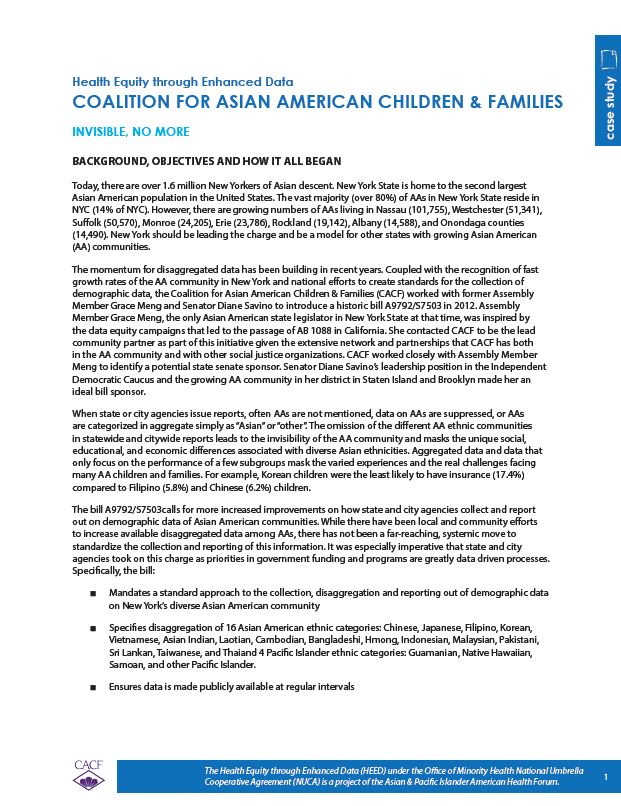Today, there are over 1.6 million New Yorkers of Asian descent. New York State is home to the second largest Asian American population in the United States. The vast majority (over 80%) of AAs in New York State reside in NYC (14% of NYC). However, there are growing numbers of AAs living in Nassau (101,755), Westchester (51,341), Suffolk (50,570), Monroe (24,205), Erie (23,786), Rockland (19,142), Albany (14,588), and Onondaga counties (14,490). New York should be leading the charge and be a model for other states with growing Asian American (AA) communities.
The momentum for disaggregated data has been building in recent years. Coupled with the recognition of fast growth rates of the AA community in New York and national efforts to create standards for the collection of demographic data, the Coalition for Asian American Children & Families (CACF) worked with former Assembly Member Grace Meng and Senator Diane Savino to introduce a historic bill A9792/S7503 in 2012. Assembly Member Grace Meng, the only Asian American state legislator in New York State at that time, was inspired by the data equity campaigns that led to the passage of AB 1088 in California. She contacted CACF to be the lead community partner as part of this initiative given the extensive network and partnerships that CACF has both in the AA community and with other social justice organizations. CACF worked closely with Assembly Member Meng to identify a potential state senate sponsor. Senator Diane Savino’s leadership position in the Independent Democratic Caucus and the growing AA community in her district in Staten Island and Brooklyn made her an ideal bill sponsor.
When state or city agencies issue reports, often AAs are not mentioned, data on AAs are suppressed, or AAs are categorized in aggregate simply as “Asian” or “other”. The omission of the different AA ethnic communities in statewide and citywide reports leads to the invisibility of the AA community and masks the unique social, educational, and economic differences associated with diverse Asian ethnicities. Aggregated data and data that only focus on the performance of a few subgroups mask the varied experiences and the real challenges facing many AA children and families. For example, Korean children were the least likely to have insurance (17.4%) compared to Filipino (5.8%) and Chinese (6.2%) children.
The bill A9792/S7503calls for more increased improvements on how state and city agencies collect and report out on demographic data of Asian American communities. While there have been local and community efforts to increase available disaggregated data among AAs, there has not been a far-reaching, systemic move to standardize the collection and reporting of this information. It was especially imperative that state and city agencies took on this charge as priorities in government funding and programs are greatly data driven processes. Specifically, the bill:
* Mandates a standard approach to the collection, disaggregation and reporting out of demographic data on New York’s diverse Asian American community
* Specifies disaggregation of 16 Asian American ethnic categories: Chinese, Japanese, Filipino, Korean, Vietnamese, Asian Indian, Laotian, Cambodian, Bangladeshi, Hmong, Indonesian, Malaysian, Pakistani, Sri Lankan, Taiwanese, and Thaiand 4 Pacific Islander ethnic categories: Guamanian, Native Hawaiian, Samoan, and other Pacific Islander.
* Ensures data is made publicly available at regular intervals
This bill was significant as it recognized that New York’s current data collection policies are insufficient and too inconsistent in representing the diverse and growing Asian American community. This bill also launched CACF’s Invisible No More campaign on data equity in 2012.
Tell us what you think about this case study. Click here to take our survey.

